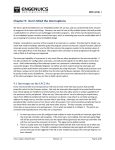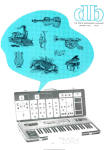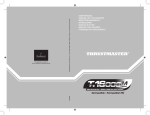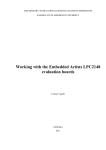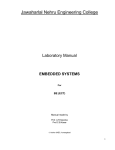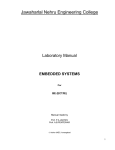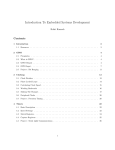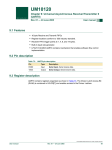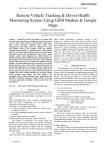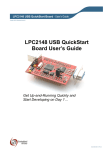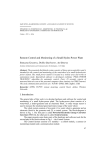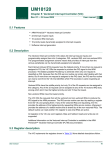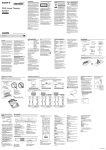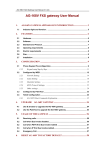Download Software development and debugging for NXP ARM7 MCUs
Transcript
THE MINISTRY of EDUCATION and SCIENCE of RUSSIAN FEDERATION SAMARA STATE AEROSPACE UNIVERSITY Software development and debugging for NXP ARM7 MCUs Learner’s guide SAMARA 2011 2 Compilers: Kudryavtsev Ilya Alexandrovich, Kornilin Dmitry Vladimirovich Software development and debugging for NXP ARM7 MCUs = Разработка и отладка программ для микроконтроллеров семейства ARM7 фирмы NXP [Electronic resource] : Learner’s guide / The Ministry of Education and Science of Russian Federation, Samara State Aerospace University; compilers I. A. Kudryavtsev, D. V. Kornilin. - Electronic text and graphic data (0,44 Mb). - Samara, 2011. - 1 CD-ROM. Learner’s guide describes the problems of creating and debugging programs in C / C++ language for NXP ARM7 MCUs. Learner’s guide is developed in the Interuniversity Space Research Department. The learner’s guide is intended for the students, studying on the educational program 010900.68 “Applied mathematics and physics”, on the discipline “Radio complexes for flight monitoring and control of the micro/nanosatellites” in A semester. © Samara State Aerospace University, 2011 3 CONTENTS INTRODUCTION……………………………………………………………….4 1 PROJECT CREATION.......................................................................................................4 2 COMPILATION AND DEBUGGING...................................................................................7 2.1 Project compilation......................................................................................................................................................7 2.2 Debug modes................................................................................................................................................................7 2.3 Viewing and modifying registers and memory variables.........................................................................................7 2.4 Using breakpoints.........................................................................................................................................................7 2.5 The use of macro functions.........................................................................................................................................8 2.6 Emulation interrupts...................................................................................................................................................8 2.7 Performance analysis and program optimization ...................................................................................................8 3 BIBLIOGRAPHY...............................................................................................................10 INTRODUCTION This lab is devoted to the studying of the programming features for 32 - bit ARM7TDMI microcontrollers in IAR EMBEDDED WORKBENCH IDE (Integrated Development Environment), developed by IAR SYSTEMS. These MCUs are highperformance devices, having Von Neumann's architecture with a rich set of peripherals. Microcontrollers have sufficient capacity (up to 512 KB) of FLASH-on-chip memory, which encourage us to write programs in high level languages, and have quick access module, which increases the performance when running the program directly from the FLASH-memory. Debugging programs with IAR Embedded Workbench in simulation mode, one can use a macro language, expanding the debugger’s possibilities. This feature can compensate the lack of direct support for peripheral devices. Code size and performance are equally important, when creating software for the real-time systems with high-level languages, like C or C++. To use IAR EMBEDDED WORKBENCH IDE in a full power developers have to know main compiler settings to optimize the program code size or speed. It is possible also to carry out an analysis of performance optimization with built-in tools, like Profiler (Profiling) and the code analyzer (Code Coverage). Studying this issue has three objectives: the getting the experience of working with the IAR, using C/C++ programming and to studying the characteristics of ARM7 microcontrollers. This guide allows students to conceive the basics of C programming for ARM7 microcontrollers with the help of IAR Embedded Workbench. This guide either do not include full description of ARM7TDMI core’s features or user’s manual for IAR Embedded Workbench. Included are only brief comments, necessary for the understanding of code examples, the appendix contains some details of technical documentation for ARM7 microcontrollers. 1 Project creation Software development will be performed, using environment IAR EMBEDDED WORKBENCH IDE, created by IAR SYSTEMS. First of all you need to create a directory with a project, containing all necessary source files, auxiliary and output files. To create new project you can use menu «Project/Create New Project». After that (fig. 1) the program offers some types of the projects. Choose «Empty project» option, then in the following window you should enter the path to your directory and project’s name. After this stage you can add or remove any sources at any time. To save the time, we shall use prepared set of files, which you can find in the directory, named «Samples» (Instructor will tell you exact path). We shall copy necessary files from this directory and put them into our project, when needed. ATTENTION ! DO NOT REMOVE, ADD OR MODIFY ANY FILES IN «Samples» DIRECTORY. YOU MAY PERFORM ALL MODIFICATIONS ONLY IN YOUR OWN DIRECTORY. To begin your work with the first project, copy from «Samples» subdirectory Configurations and files Main.cpp, lcd.cpp. Figure 1 – Project creation In the window Workspace in the left part of your workspace you can see two default project configurations: Debug and Release. We can also add our own configurations, for example, it is useful to have a configuration, loading code into the internal RAM. It is essential to use Debug configuration for debugging and Release configuration – for the final project with necessary optimizations. Figure 2 – MCU selection We shall use Debug configuration for the simulation and Release configuration for the placement of the code in the Flash memory of microcontroller. RAM configuration will be used for the experiments with the code, placed in RAM. Now we shall define our configurations. The first will be Debug configuration. Select this configuration, then click the name of the project with the right mouse button and select tab «Options…», then you will see the window, shown on fig. 2. Now select «General Options» tab and CPU type – LPC2148 of NXP company. For using С++ syntax you need to select С/С++ compiler tab and mark «Automatic» or «Embedded C++» in «Language» group. Select «Debugger» and set «Simulator» in the window «Driver». Other options we shall leave unchanged. To define debug configuration with code placement in FLASH memory («Release» configuration) select the same MCU, then select «Linker», put the mark in the field «Override default» and enter the path to the file LPC2148_flash.icf, which is placed in the subdirectory Configurations. Select «Debugger» again and set the mark J-Link/J-Trace in «Driver» window. To create configuration with the placement of the code in RAM select menu «Project\Edit Configurations», then «New» and create new configuration with the name RAM. Customize this configuration in the same way, as earlier, then select «Debugger» in the «Categories» window and select a debugger, as shown on the fig. 3. Mark «Use macro file(s)» and set the path to the file LPC2148_RAM.mac, which is placed in the subdirectory Configurations. Then select «Linker», mark «Override default» and set the path to the file LPC2148_RAM.icf in the same subdirectory. Figure 3 – Customizing the debugger Now click right mouse button over «Add Files» and add the files «Main.cpp» and «lcd.cpp». The project is ready for the compilation and debugging. 2 Compilation and debugging 2.1 Project compilation To translate and link the object file you can use PROJECT menu and activate MAKE or COMPILE tab. After the completion of the process, the program opens MESSAGES window, if errors or warnings are present. 2.2 Debug modes Select Debug configuration, which is intended for the simulation purposes. To start debugger select «Download and Debug» in PROJECT menu, then debugger will start automatically, and a cursor will be placed on the «main» function. Debugger allows executing the program step-by-step, using F10/F11 or a pictogram in the toolbox panel. Pressing F10 you make the debugger to execute one instruction in one step. If it is a subroutine call, it would be executed as one instruction. Using F11 you can merge in the subroutine and execute it as a separate program. You can also start the program in automatic mode with preliminary setting of breakpoints (see details below). In addition, you can execute the program with a delay (AUTOSTEP), in which commands are executed with adjustable delay. Also, you can use mode with a stop at the cursor position, performing before the release of the subroutine. 2.3 Viewing and modifying registers and memory variables To modify the register you should open the window «Register» (Register tab menu View). To modify the registry you can type the value directly in the box and press ENTER. It is useful to view and modify variables window «Watch». Using a right-click in this box, you can add (ADD), remove (REMOVE) or change the display format of the variable. In the «Quick watch» window you can also see the value of variables whose values are not necessarily inspected all the time. If necessary, you can transfer temporary variable in a permanent window WATCH. You should add symbol "#" to the first character of the name of registers, for example, to display the content of the IO0DIR, enter #IO0DIR. To view and modify memory locations you can use MEMORY tab. This opens a dialog box where you can view and modify the desired cell. For your convenience, you can display a separate area of memory related to the RAM, FLASH, etc. With this window you can also set the breakpoint on access to individual memory cells or the entire range. 2.4 Using breakpoints Used programming environment suggests the possibility of using three types of breakpoints: in particular instruction code, to access a memory location and the point of interruption instead of stopping the execution of the program (Immediate). To edit a breakpoint, you can use the tab «Edit breakpoints», which opens a special dialog box. To set a breakpoint user manual can use the context menu in the corresponding position of the cursor. To set a breakpoint on memory access it is convenient to use the window «Memory». Debugging the interrupt’s routine it is convenient to use a macro function, connected with the breakpoint, which would automatically modify memory or display any information. To do this edit box «Action», which have to specify the name of the macro functions. 2.5 The use of macro functions Macro functions are to be created in separate files with «mac» extension. To use macro function, you should use menu «Debug/Macros», enter the name of the file, containing macros, then add it to the list of available macro functions («Add») and register it («Register»). 2.6 Emulation interrupts To emulate interrupts you should use the tab «Interrupts» from menu «Simulator». Activate checkbox «Enable», select the desired interrupt vector, then specify the number of cycles until first occurrence («First Activation»), repetition period of «Repeat interval». You can also define the duration of the interrupt request «Hold time» (specify «Infinite»), the probability of interruption in the period in percents and its deviation, if needed. There is also the possibility of manual activation of the interrupt at any time by using the menu «Simulator/Forced Interrupts». In the list you should select the desired vector, and then click «Trigger». 2.7 Performance analysis and program optimization To analyze the efficiency of the program, there are two tools: analyzer and profiler code execution. The profiler can be started from the menu «View/Profiling». Profiler provides numerical data (in cycles) and relative (in percents) of pure run-time of selected functions and the overall run-time, including library functions. Analyzing these data, we can make conclusions about the bottlenecks in the program and find the ways of code optimization. Performance analyzer («View/Code Coverage») is intended to search the parts of the program, which are not executed for some reasons. Such functions are marked by the red color, green color designates functions, performed entirely, red and green partially executed. Inside the "red" functions, you can see the individual "yellow" transitions to non-executed code. Return to the Source Editor and open the settings dialog compiler («Project / Options / C + + Compiler»). By selecting the tab «Code», you can do some experiment with the compiler settings, observing the results in the debugger. After debugging code, you ought to perform the procedure of the optimization and check the program for its functionality. This is necessary because during the optimization process, compiler can discard the execution of certain functions which ap- pears to be unnecessary (from compiler’s point of view), for example, repeated switching the direction of the port from input to output. Make some experiments with the profiler and analyzer, changing the way of code optimization and the frequency of the generated interrupts. 3 Bibliography 1. 2. 3. Trevor Martin The insider’s guide to the Philips ARM7 – BASED MICROCONTROLLERS. An engineer’s introduction to the LPC 2000 Series. UM10139 Volume 1: LPC214X User Manual Rev.01 – 15 August 2005. ARM7 TDMI Rev.3 Technical Reference Manual Appendix A Table A.1 IO ports control registers Name IOXPIN description Designed to read the state of pin access R/W State after reset - IOXSET Recording 1 set high logic level at pin R/W 0x00000000 IOXCLR Recording 1 set low logic level at pin R/W 0x00000000 IOXDIR The direction of transmission. Recording 1 configures the output mode to output R/W 0x00000000 Appendix B Table B.1 UART0 Registers The formula for calculating the UART transmission rate The main registers: U0RSR - register the received data; U0THR - data register for transmission; U0IER - Interrupt Enable UART: Bit 0 - 1 - enable interrupt if the received data; Bit 1 - 1 - enable interrupt when buffer under the program; Bit 2 - 1 - enable interrupt when a particular state line RX U0LSR - line control status register: Configures the format make [3]; U0LSR - line status register: Current status of the port (error) Appendix C Figure C.1 - Formats the transfer module in SPI Table C.1 SPI module registers The most important registers are: S0SPCR - control register, the format detailed in [3]; S0SPSR - status register reflects the current state (error); S0SPDR - register containing the transmitted and received data; S0SPCCR-register control the frequency transmit mode MASTER. Appendix D Table D.1 The timer registers The main registers: (X - 0 or 1, depending on the timer) ThTCR - control register; TxTC - count register; TxPR - register prescaler; TxMR0 - register containing the value at which the match interrupt is generated and the counter is reset; TxMCR - control register mode matching; TxIR - timer interrupt control register. Appendix E Table E.1 ADC registers The main registers: ADCR - control register; ADGDR - a register containing the result and the last bit of preparedness; ADSTAT - ADC status register (all channels); ADDRX - the result register of the channel. Table E.2 Format Registry DACR (0xE006C000) DAC control To activate the DAC to set bits 19:18 in the state register PINSEL1 "10" Appendix F Table F.1 interrupt controller registers The main registers: VicSoftInt - register bits which correspond to the existing demand at the moment interrupts; VicSoftIntClear - register reset VicSoftInt; VicIntEnable - register an individual permit / prohibit interrupt; VicIntEnClear - register reset VicIntEnable; VicIntSelect - register selection anchor (IRQ or FIQ) for each interrupt; VicVectCntl0-15 - slots Registers IRQ (bit resolution and contain a number of slots for each of the 16 vector interrupt IRQ); VicVectAddr0-15 - Address registers vectors IRQ; VicVectDefAddr - address register handler of non-vectored IRQ; VicVectAddr - register containing the address of the treated IRQ; VicProtection - register to enable access to the registers of VIC. Table F.2 Interrupt Sources Educational edition Software development and debugging for NXP ARM7 MCUs Learner’s guide. Compilers: Ilya Kudryavtsev, Dmitry Kornilin Samara State Aerospace University (SSAU)


















